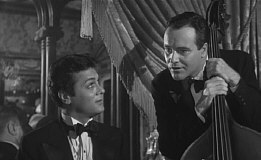 Perhaps it’s a sign of the “generation gap”, or perhaps it simply indicates that I’m a moron, but here’s Factoid That Strongly Dates Me: when I hear the phrase “some like it hot”, my thoughts don’t usually connect to the classic 1959 film of the same name. Instead, my immediate mental image relates to the not-so-classic 1985 song of the same name by short-lived “super group” Power Station. Hey, I still like that tune!
Perhaps it’s a sign of the “generation gap”, or perhaps it simply indicates that I’m a moron, but here’s Factoid That Strongly Dates Me: when I hear the phrase “some like it hot”, my thoughts don’t usually connect to the classic 1959 film of the same name. Instead, my immediate mental image relates to the not-so-classic 1985 song of the same name by short-lived “super group” Power Station. Hey, I still like that tune!
Although the ditty dominates my memories, I’m not a total buffoon. I’ve known about the film for many years, though I’m not terribly certain I ever saw it prior to its current DVD release. I took in quite a few older flicks back in the Eighties, and while I think I might have checked out SLIH, I’m not sure of this.
You can chalk that up to faulty memory, I suppose, but in my defense, there are some movies that are so famous that sometimes people think they’ve seen them when they haven’t. Because many of the images that surround SLIH are so famous, it’s quite easy to believe that I’d watched the movie when I never viewed it.
Now that we’ve firmly established that I may or may not have screened Some Like It Hot at some point in my life, I suppose I can go on to my thoughts about the movie itself. This sucker has to live up to a tremendous reputation. It placed 14th on the AFI’s Top 100 Movies of all-time list, and it made number one on their specialty chart that documented their choices for the best comedies. SLIH is the funniest film of all-time? I can’t agree with that, but I did think that it provided a consistently entertaining and enjoyable experience.
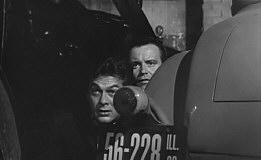 Set in Prohibition-era Chicago at the end of the Twenties, SLIH stars Tony Curtis and Jack Lemmon as Joe and Jerry respectively, two jazz musicians who perpetually encounter economic troubles. They land a good gig at a speakeasy but lose that when the joint’s raided. After that, they witness the killing of the informant who ratted on crime boss “Spats” Colombo (George Raft) so they have to go on the lam to avoid their own untimely deaths.
Set in Prohibition-era Chicago at the end of the Twenties, SLIH stars Tony Curtis and Jack Lemmon as Joe and Jerry respectively, two jazz musicians who perpetually encounter economic troubles. They land a good gig at a speakeasy but lose that when the joint’s raided. After that, they witness the killing of the informant who ratted on crime boss “Spats” Colombo (George Raft) so they have to go on the lam to avoid their own untimely deaths.
As such, they don feminine garb and transform themselves into “Josephine” and “Daphne” to join an all-girl band for a nice gig in Florida. Inevitably the crooks catch up with them, but not until after they’ve run into many other complications. Both Joe and Jerry fall for sexy singing star Sugar (Marilyn Monroe), and Joe actually takes on another persona as a rich oil tycoon to nab the babe. Jerry hits his own snag when an older millionaire named Osgood (Joe E. Brown) decides to make Daphne his eighth or ninth wife.
When a film prominently features actors in drag, it tends to be of the madcap comedy variety, and SLIH remains the granddaddy - or grandma - of them all. Since I’m much better acquainted with more recent flicks of this ilk such as 1993’s Mrs. Doubtfire and 1982’s Tootsie, it was something of a revelation to check out this seminal movie. All subsequent drag-oriented pictures owe some debt to SLIH, but Tootsie really seems heavily inspired. As played by Jessica Lange, that film’s Julie really is nothing more than the daughter of Sugar; from Lange’s breathy delivery to the characters’ shared penchant for booze, the parts seemed awfully similar. I also saw a number of scenes in Tootsie that had close cousins in SLIH; for example, a segment in the latter which shows Daphne and Sugar in bed appeared very much like a bed piece in the former.
I don’t mean to accuse Tootsie of blatantly ripping off SLIH; both films clearly have their own identities, and the former is not just a cheap imitation. However, I really was surprised to see how much of the older movie showed up in Tootsie; I didn’t expect so many strong similarities.
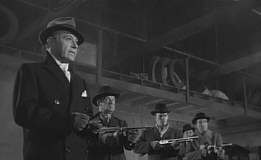 Of course, one main difference stems from the fact that SLIH offers two guys in drag as opposed to the single cross-dresser in Tootsie. Curtis and Lemmon take rather different approaches to their roles, and they didn’t follow the methods I thought they would. Early in the film, Lemmon’s Jerry is somewhat uptight and nerdy; he worries incessantly about money and comes across as a bit of a fuss-budget. Joe, on the other hand, is a smooth ladies’ man who doesn’t seem to worry about much; he figures he can always sweet-talk a living for the two.
Of course, one main difference stems from the fact that SLIH offers two guys in drag as opposed to the single cross-dresser in Tootsie. Curtis and Lemmon take rather different approaches to their roles, and they didn’t follow the methods I thought they would. Early in the film, Lemmon’s Jerry is somewhat uptight and nerdy; he worries incessantly about money and comes across as a bit of a fuss-budget. Joe, on the other hand, is a smooth ladies’ man who doesn’t seem to worry about much; he figures he can always sweet-talk a living for the two.
However, when the dresses go on, the personalities change somewhat. As Daphne, Jerry remains concerned with money; in fact, he appears fairly obsessed with finances. However, he becomes much looser in his new personality; they’re earning a steady living, and “girls” just wanna have fun!
While Jerry’s the business man of the pair, Joe possesses the street smarts, so he remains more practical during their spree as women; he knows that the hoods from Chicago will still be after them, so he becomes the practical one. Joe sees dressing in drag as a means to an end, while Jerry… well, he seems to enjoy it just a little too much.
Actually, those elements of the film were a pleasant surprise. No, Lemmon isn’t shown to get off due to the feel of his ladies’ garb, but he becomes rather wrapped up in his role; he appears to forget his initial sexual interest in Sugar when he finds a rich “prospect” in Osgood. Lemmon really lets himself go in the part, as he unselfconsciously dives into the part. He could seem a bit caustic and forced at times, but I still thought he provided a perverse glee to Jerry/Daphne that I didn’t expect.
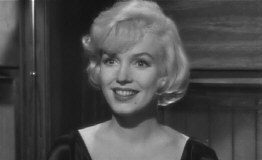 Even more surprising was the solid turn from Curtis. To be honest, I haven’t seen a lot of his work, but I’ve not been impressed with the bits I have witnessed; I thought his performance in Spartacus was one of that flick’s weakest points. However, he appeared wonderfully loose and lively here as he takes on three different personalities and acts convincingly in all of them. Most impressive was the dead-on Cary Grant impression he adopts as the oil tycoon, an element that added more wit to the piece.
Even more surprising was the solid turn from Curtis. To be honest, I haven’t seen a lot of his work, but I’ve not been impressed with the bits I have witnessed; I thought his performance in Spartacus was one of that flick’s weakest points. However, he appeared wonderfully loose and lively here as he takes on three different personalities and acts convincingly in all of them. Most impressive was the dead-on Cary Grant impression he adopts as the oil tycoon, an element that added more wit to the piece.
As for Marilyn, many people feel that this was one of her top performances. While I haven’t watched a lot of her films, frankly I don’t see this as an outstanding piece of work. It just seemed like Marilyn played Marilyn; I didn’t discern much variation on the theme, especially since the movie doesn’t provide a great deal of character development. If I had to pick one real flaw in SLIH, that would be it; I thought the different participants largely seemed one-dimensional and lacked much depth.
Still, the film worked well even without well-defined characters, especially because of the folks not in the lead parts. A lot of the movie’s entertainment came from the antics of some supporting players. Brown is consistently dryly hilarious as Osgood, and the cocky bellhop - whose name I can’t discover - really enlivened his brief stints on the screen. The film features a solid crew who all offer strong work.
As for the movie’s vaunted humor, I do have to agree that it’s a funny piece. The funniest movie ever? Definitely not, but much of the movie’s lines and gags hold up extremely well. The film boasts a bright and sassy script filled with memorable jokes, and it manages to keep them coming at a fast and furious pace. I can’t say that Some Like It Hot will ever become one of my favorite comedies, but I definitely enjoyed it and I look forward to future viewings of this witty and endearing classic.
The DVD:
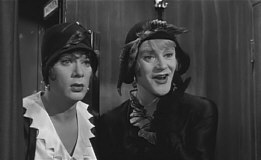 Some Like It Hot appears in an aspect ratio of approximately 1.66:1 on this single-sided, dual-layered DVD; the image has not been enhanced for 16X9 televisions. Though the picture showed its age during a variety of occasions, as a whole I thought it presented a consistently watchable visual experience.
Some Like It Hot appears in an aspect ratio of approximately 1.66:1 on this single-sided, dual-layered DVD; the image has not been enhanced for 16X9 televisions. Though the picture showed its age during a variety of occasions, as a whole I thought it presented a consistently watchable visual experience.
Sharpness generally seemed quite good. At times, I discerned a little fuzziness during some wider shots, and I also saw use of mild soft-focus during close-ups on Marilyn. Nonetheless, most of the film appeared acceptably crisp and well-defined. Modest examples of moiré effects and jagged edges showed up during the movie.
For the most part, black levels seemed fairly good. I thought SLIH portrayed generally solid contrast with some dark tones that looked adequately deep and rich. Shadow detail was appropriately heavy but not excessively thick; I thought the low-light sequences seemed easily visible but not overly bright.
Typically, older movies suffer most from print flaws, and that was definitely the case with SLIH. Though the film wasn’t crawling with defects, I still saw quite a few of them. The usual mix of grit and speckles comprised most of the problems, and the movie could seem fairly grainy at times. In addition, a variety of blotches, nicks, and spots also marred the image. Strangely, substantial portions of the flick passed without much incident, but once the defects cropped up again, they tended to become pretty heavy. As such, although much of the movie seemed fairly clean, quite a lot of it appeared dirty and flawed. For the most part, Some Like It Hot looked acceptably good for its age, but I can’t help but think that some restoration work could bring the title much closer to its original glory.
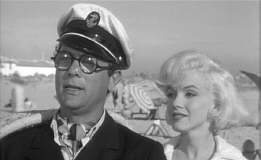 The DVD of Some Like It Hot provided a new Dolby Digital 5.1 remix in addition to the original monaural soundtrack; only the multichannel mix was screened for this review, although I did check out a few snippets of the mono track. Although the audio definitely displayed the limitations of the source material, I thought it generally provided a decent listening experience.
The DVD of Some Like It Hot provided a new Dolby Digital 5.1 remix in addition to the original monaural soundtrack; only the multichannel mix was screened for this review, although I did check out a few snippets of the mono track. Although the audio definitely displayed the limitations of the source material, I thought it generally provided a decent listening experience.
Despite the new 5.1 remix, the soundfield remained fairly heavily anchored to the center channel. The side speakers added modest breadth to the imaging at times, mainly via the musical numbers heard throughout the film. Stereo separation didn’t seem especially strong, but the tunes and score spread adequately from the center. Effects also showed moderate extension to the right and left. This mostly provided ambient audio, but some decent panning occurred at times, such as when vehicles moved from one side to the other; scenes on the train easily showed the best dimensionality to the mix. Surround usage seemed limited largely to minor reinforcement, though the rears kicked in with fairly positive activity during some musical numbers. As a whole, the soundfield broadened the original track but stayed true to its roots, which was fine with me.
Audio quality seemed erratic but acceptable for a film of this era. Dialogue displayed some edgy qualities and could appear somewhat brittle, but I found that speech remained acceptably distinct and were always easily intelligible. Apparently many of Tony Curtis’ lines were dubbed because he had trouble with a convincing female voice, but I thought the looping was integrated in a generally seamless manner. As I watched the movie, I debated whether or not the voice I heard was Curtis’, but not because the words didn’t fit in well with the action. No, I just thought it didn’t sound much like Curtis, but I felt the lines meshed neatly with the presentation.
 Effects also displayed periodic signs of distortion. Louder noises such as gunshots had the most problems, but a few other elements showed minor concerns as well. Nonetheless, most of the effects were acceptably clear and realistic for an older movie; these pieces seemed somewhat thin and bland, but they still were adequate. Probably the best parts of the soundtrack related to the music. These parts also could lack dynamics, but they generally were fairly crisp and bright, and the score and songs actually displayed some relatively decent low-end at times. Bass response seemed loose but was deep for the era. I very much liked the effect heard when the camera first approaches Curtis and Lemmon; as it nears Jack, the thump of his bass playing gets louder. Ultimately, the soundtrack to Some Like It Hot had problems and it didn’t compare to something more modern, but I felt it was a consistently listenable and satisfactory mix for its period.
Effects also displayed periodic signs of distortion. Louder noises such as gunshots had the most problems, but a few other elements showed minor concerns as well. Nonetheless, most of the effects were acceptably clear and realistic for an older movie; these pieces seemed somewhat thin and bland, but they still were adequate. Probably the best parts of the soundtrack related to the music. These parts also could lack dynamics, but they generally were fairly crisp and bright, and the score and songs actually displayed some relatively decent low-end at times. Bass response seemed loose but was deep for the era. I very much liked the effect heard when the camera first approaches Curtis and Lemmon; as it nears Jack, the thump of his bass playing gets louder. Ultimately, the soundtrack to Some Like It Hot had problems and it didn’t compare to something more modern, but I felt it was a consistently listenable and satisfactory mix for its period.
As I noted, I also checked out the monaural track on occasion in order to hear if any sonic differences occurred. From what I discerned, the 5.1 track possessed the stronger dynamics. Though the dissimilarities were few, I thought that the multichannel mix showed better bass response, and the highs appeared a little cleaner and clearer. As a whole, the two track matched up fairly closely, but I felt that the 5.1 version offered the superior experience.
On this special edition release of Some Like It Hot, we find a decent smattering of extras. First up is a Nostalgic Look Back with Tony Curtis. This 31-minute and 10-second program is a recent interview with Curtis conducted by film critic Leonard Maltin. Recorded at the Formosa Café - a Hollywood landmark near the studio at which SLIH was filmed - Curtis provides a nicely frank and entertaining remembrance of his days on the movie. In recent years, Curtis has seemed like a rather odd man during interviews, but he manages to keep himself largely in check here, and he adds a lot of fun and informative notes throughout this piece. He doesn’t dish any real dirt, but he does relate some idea of how difficult it could be to work with Marilyn, and he gives a solid overview of his experiences. Ultimately, I enjoyed this show and thought it added to my appreciation of the film.
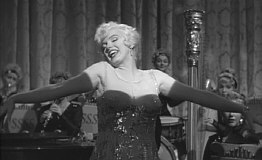 In the same vein is Memories From the Sweet Sues, a 12-minute program in which we hear from some of the members of the movie’s all-girl band. Here we find actresses Marian Collier, Laurie Mitchell, Sandra Warner, and Joan Nicholas, all of whom were recorded together for this piece. Their remembrances lack the insight heard during Curtis’ interview, and the parts during which they watch film clips and gush about the greatness of the flick get a little old, but the ladies still give a nice perspective on the experience.
In the same vein is Memories From the Sweet Sues, a 12-minute program in which we hear from some of the members of the movie’s all-girl band. Here we find actresses Marian Collier, Laurie Mitchell, Sandra Warner, and Joan Nicholas, all of whom were recorded together for this piece. Their remembrances lack the insight heard during Curtis’ interview, and the parts during which they watch film clips and gush about the greatness of the flick get a little old, but the ladies still give a nice perspective on the experience.
Best of the bunch are two Marilyn-related tidbits. In one we learn how director Billy Wilder lured Monroe out of her dressing room when she has refused to come onto the set, and in the other we find out whose body appears in the film’s publicity shots. Ultimately, “Memories” was generally fun and compelling.
The Virtual Hall of Memories essentially functions as a running montage. When you enter the “hall”, you move through five different areas: Monroe, Curtis, Lemmon, Wilder, and “Behind the Scenes”. In each of these departments, you’ll see a mix of production stills, publicity shots, and film clips, all of which were filmed and backed with audio from the movie. As a whole, the piece runs for 21 minutes. I could have done without the film snippets - after all, we already own the movie on its own - but the photos were quite good to see.
In the Pressbook Gallery we fine some stillframe materials. There are 24 frames of clippings from the movie’s pressbook. These comprise various ads and articles about the flick, and they offer a nice mix of elements from the era. My only complaint related to their size; some smaller images were too difficult to see in their current incarnations. Nonetheless, this was a nice addition to the package.
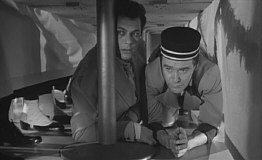 Lastly, we get some short but decent production notes in the DVD’s booklet, and we also find a slew of ads. The DVD includes the original theatrical trailer for SLIH itself and we get additional promos for a mix of other films directed by Billy Wilder films. There are clips for Avanti, The Private Life of Sherlock Holmes, The Fortune Cookie, Kiss Me, Stupid, The Apartment, and Irma La Douce.
Lastly, we get some short but decent production notes in the DVD’s booklet, and we also find a slew of ads. The DVD includes the original theatrical trailer for SLIH itself and we get additional promos for a mix of other films directed by Billy Wilder films. There are clips for Avanti, The Private Life of Sherlock Holmes, The Fortune Cookie, Kiss Me, Stupid, The Apartment, and Irma La Douce.
While I can’t call this a spectacular array of extras, I thought it was a fairly positive package. However, I did think it was disappointing that Jack Lemmon didn’t participate in any of the pieces. Actually, I also wish we could have heard from Wilder as well, but as the age of almost 95, he may not be up for this kind of enterprise. In any case, it’s a let down that two of the film’s three surviving principals didn’t show up here.
Nonetheless, I liked the DVD of Some Like It Hot. The movie itself has endured quite well over the years. While I can’t endorse the AFI’s decision that it’s the funniest film ever made, I still thought it was witty and well-made as a whole. The DVD offers erratic but generally acceptable picture and sound plus a few good extras.
Some Like It Hot can be purchased as either a special edition with a list price of $24.98 or a “movie-only” version that runs for $14.95. The latter is a steal if you don’t care about supplements; though the quality of the film’s transfer isn’t extraordinary, it was more than adequate, and that low price can’t be topped. Personally, I prefer the special edition just because I like extras. The supplements found on that disc aren’t terrific, but they were well worth a look, and in the case of the nice mix of photos, I’m sure I’d want to check them out again in the future. Either DVD should join your collection. I’d go with the SE, but the movie-only disc is also a solid choice for anyone who doesn’t feel enthralled by extras.